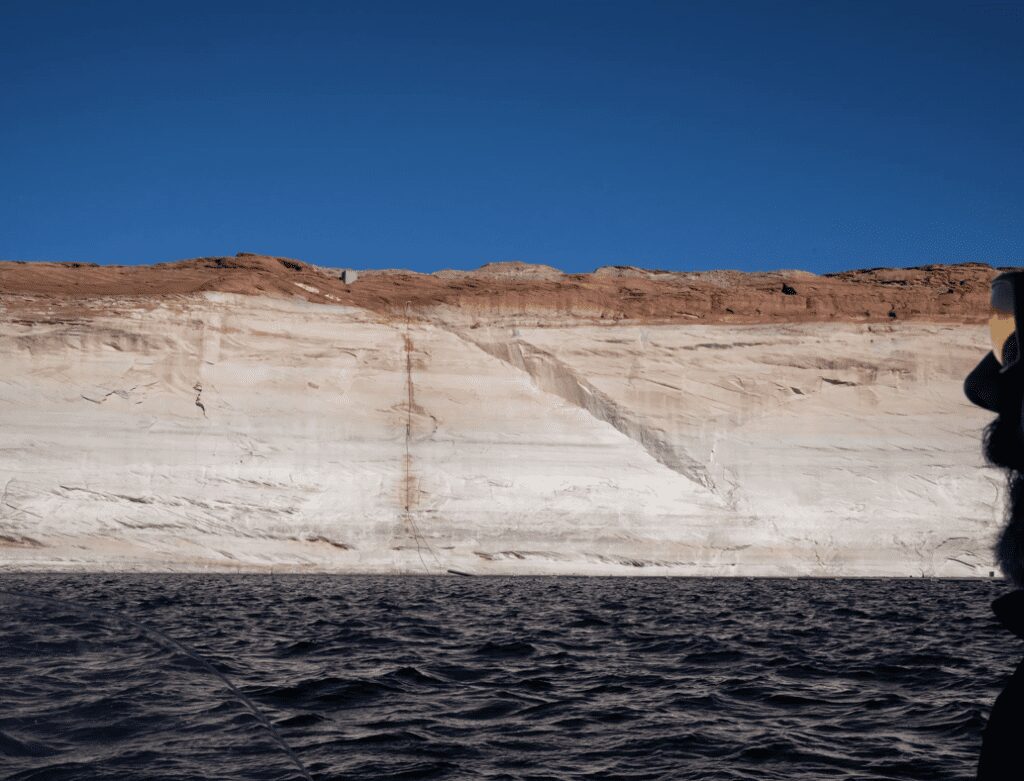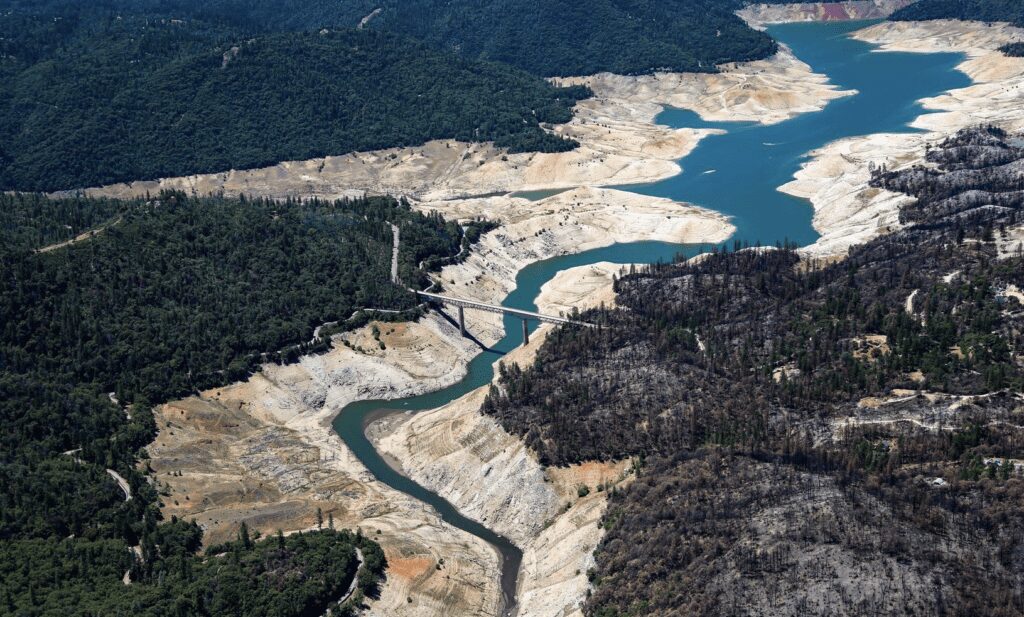Daniel Salzler No. 1140
EnviroInsight.org Three Items March 11, 2022 —————Feel Free To Pass This Along To Others——————
If your watershed is doing something you would like others to know about, or you know of something others can benefit from, let me know and I will place it in this Information newsletter.
If you want to be removed from the distribution list, please let me know.
Please note that all meetings listed are open.
Enhance your viewing by downloading the pdf file to view photos, etc. The
attached is all about improving life in the watershed. If you want to be removed from
the distribution list, please let me know. Please note that all meetings listed are open.
Check our website at EnviroInsight.org
1.Dry Boat Ramps, Exposed Rocks At Lake Powell Reveal The Cost Of Colorado River Drought. Glen Canyone National Recreation Area — A small bucket loader scraped Wahweap Bay’s expanding strip of red mud and gravel, its operator smoothing the shoreline where concrete workers were busy chasing a lake in retreat.
To the left, where the bay had long offered kayakersand water skiers a loop around Lone Rock, the monumental slab now rose from dust flats instead of from flat water. To the right, in the channel that leads to Glen Canyon Dam and the Colorado River’s sunken bed, formerly submerged islands and peninsulas mapped out a warming climate’s continuing transformation of one of America’s great water stores and pleasure grounds. A desert flooded by impounded waters in the last century has visibly reasserted itself in this one.
On this February day, the earth movers and concrete workers prepared to harden the latest extension where this spring fun seekers will queue up on Lake Powell’s boat ramp.
That’s ramp, not ramps, on a reservoir that stretches about 180 miles upriver into Utah and usually offers boaters a choice of at least eight put-ins.

Two decades of aridification and spiraling water demands already had exposed more than 120 feet of Glen Canyon Dam concrete before the last year sapped another 45 feet. That plung caused the National Park Service to press the concrete crew into action so at least one access for speedboats and houseboats would remain as the season warms to life in March. It’s doing so at a once-submerged and long-forgotten ramp, the only one with immediate access to the shore.
But continued shrinkage would imperil much more than a boating season. From the hydropower plant at the dam to threatened fish species downstream in Grand Canyon to farms and other water users in seven states and Mexico, Lake Powell’s decline now complicates life in the West.
“We’re viewing this as a crisis,” Glen Canyon Superintendent William Shott said.
Fall 2021 visitation declined precipitously with the water, he noted. He hoped the inconvenience and fears of ramp crowding would not turn away so many boaters and vacationers that houseboat service providers and other Page businesses will suffer this season. “These are my neighbors, right?”
That’s ramp, not ramps, on a reservoir that stretches about 180 miles upriver into Utah and usually offers boaters a choice of at least eight put-ins.
Two decades of aridification and spiraling water demands already had exposed more than 120 feet of Glen Canyon Dam concrete before the last year sapped another 45 feet. That plunge caused the National Park Service to press the concrete crew into action so at least one access for speedboats and houseboats would remain as the season warms to life in March. It’s doing so at a once-submerged and long-forgotten ramp, the only one with immediate access to the shore.
But continued shrinkage would imperil much more than a boating season. From the hydropower plant at the dam to threatened fish species downstream in Grand Canyon to farms and other water users in seven states and Mexico, Lake Powell’s decline now complicates life in the West.
“We’re viewing this as a crisis,” Glen Canyon Superintendent William Shott said.
Fall 2021 visitation declined precipitously with the water, he noted. He hoped the inconvenience and fears of ramp crowding would not turn away so many boaters and vacationers that houseboat service providers and other Page businesses will suffer this season. “These are my neighbors, right?
The river and its reservoir have experienced the Southwest’s driest multidecade “megadrought” in at least 1,200 years, according to a study led by UCLA researchers. Such aridification would likely take more than a single wet year to reverse, according to lead author Park Williams. That study follows a number of others in recent years showing that rising temperatures put more demand on the region’s water, worsening the effects of poor precipitation.
Second only to Lake Mead among American freshwater reservoirs, Lake Powell was brimming when the drought began around the turn of this century. Today it’s about a quarter full. The extent of last year’s plunge surprised park managers, and for about a month the businesses that clean, supply and launch houseboats for vacationers had nowhere to launch them.
At Glen Canyon, the park’s enabling legislation specifically mandates prioritization of lake recreation, and Shott is planning to restore some services across the reservoir, starting immediately with a $5 million investment to deepen and upgrade drinking water wells that are starting to dry up.
Nonetheless, many of the millions who visit may be surprised to see lines on the ramp, or new rocky terrain jutting up from the former depth.
Low water has stranded the dock at Rainbow Bridge, a neighboring rock formation and national monument that most visitors access by boats on Lake Powell. Boaters now must visit at their own risk, and park concessionaire Aramark won’t be able to conduct boat tours to Rainbow Bridge this summer.
Rainbow Bridge had attracted more than 100,000 visitors a year prior to the pandemic, but dropped below 4,000 in 2020 and 2021, according to Park Service records. A spokesman for Aramark did not respond to a question about how many of them participated in the boat tours, but said in an email that low water has “not impacted boating recreation or the overall experience at the lake” and that “Lake Powell is open for business.”
Some who rely on the lake for their living are starting to imagine the close of business. The father-son team of McNabb Fishing Guide Service, the reservoir’s busiest sportfishing operation, fear their decades on the water may be waning.
“It’s bittersweet, (because) we’re getting to see new areas” of the formerly submerged Glen Canyon, the younger guide, Paul McNabb, said. But, “I think it’s the beginning of the end.”
2. Impacts of Climate Change Now Severe and Widespread, U.N. Panel Says. Based on 34,000 studies, a new report says major weather events are more common and severe than previously predicted.

Storms, heat waves, droughts and other extreme weather events are occurring more frequently and with greater severity than experts had predicted several years ago and are now causing serious health and economic impacts the world over, a panel of scientists convened by the United Nations said Monday in a new report.
Climate experts called the report the direst assessment of the impacts of climate change ever offered by the U.N. Intergovernmental Panel on Climate Change, which has been issuing climate assessments for more than three decades.
“The new contribution of this report shows how much faster these things are happening than we originally thought,” said Sherilee Harper, a University of Alberta climate scientist and a lead author of the report.
Severe weather events fueled by global warming resulting from the burning of fossil fuels and other human activities have led to “widespread, pervasive impacts to ecosystems, people, settlements, and infrastructure,” according to the report. The report cites the extreme wildfires that hit Alaska in 2015 and severe rainfall in Texas brought by Hurricane Harvey in 2017. It comes months after a deadly heat wave hit the Pacific Northwest.
Steps taken by some governments to adapt to climate change, such as the erection of seawalls in coastal areas and the implementation of systems that warn the public about looming heat waves, have helped reduce the impacts of such events, the report said. But the report warns that the current level of preparedness globally will be insufficient to avert costly and far-reaching consequences of extreme weather events in coming decades—and that there may be a growing need for more radical strategies, including resettlement away from vulnerable areas.
People are suffering and dying right now from climate change, and we’re not seeing an investment to try and make sure that we are prepared for an even warmer future,” said Kristie Ebi, a professor of global health at the University of Washington and a lead author of the report.
The report, the most comprehensive assessment of the impacts of climate change since 2014, is based on more than 34,000 studies and was compiled by 270 scientists from 67 countries. The reports are intended to help government leaders establish science-based climate policies.
“We’ve seen graphic compelling evidence around the world of the impacts of climate change on people and on nature,” said Jane Lubchenco, deputy director for climate and environment at the White House Office of Science and Technology Policy, who wasn’t involved with the report. “The report documents what we know about what is already happening and how it is creating real challenges for people.”
Along with new data on extreme weather events during the past decade, the scientists who prepared the report made use of recent advances in attribution science. This emerging subfield of climate research seeks to determine with greater precision the role climate change plays in extreme weather events and project the growing health consequences of a warming climate, including foodborne and waterborne illnesses and infections transmitted by insects.
“What you see here is an overwhelming and unfortunately confident attribution of current damages and current impacts to anthropogenic climate change,” said Gavin Schmidt, a climate scientist at the National Aeronautics and Space Administration.
In 2015, as part of the Paris Agreement, nearly 200 countries agreed to take steps to limit the rise in the global average surface temperature from preindustrial levels to “well below” 2 degrees Celsius—and ideally no more than 1.5 degrees Celsius.
Human activities have already led to global warming of about 1 degree Celsius above preindustrial levels, according to an IPCC assessment released in 2018. If warming progresses at the current rate, temperatures will reach 1.5 degrees above preindustrial levels between 2030 and 2052, that report concluded.
Between 3.3 billion and 3.6 billion people, or nearly half the world’s population, live under circumstances that make them especially vulnerable to the effects of climate change, according to the new report. Those at special risk include impoverished people, those with poor access to healthcare and those living in low-lying, flood-prone areas or in the path of recurrent storms.
Parts of Africa, South Asia, and Central and South America are among the regions that will face the most severe impacts, according to the report. And because they are tied so closely to the land and affected so directly by impacts to the environment, the report said, indigenous people are already seeing irreversible changes to their ways of life and are among those expected to feel the worst effects.
At a major climate meeting last year in Glasgow, nations updated their pledges to take steps to rein in climate change. Many countries aren’t on track to reach their goals, according to a report issued by the U.N. in October.

In the U.S., proposed legislation backed by President Biden meant to pivot the country from fossil fuels to renewable sources of energy has faltered in Congress.
But “widespread action is really urgently needed, more urgently now than previously thought, and that window for action is rapidly closing,” said Dr. Harper. “Every choice we make now can either take us closer to or further away from a climate-resilient future.” Source: Wall Street Journal Feb 28, 2022
The U.S. Bureau of Reclamation is working with states to forestall further depletion of Lake Powell. Along with the states that rely on the dam’s releases to shore up supplies downstream in Lake Mead, the agency seeks to protect a buffer above what’s needed to keep producing hydropower. The goal is to keep the surface at least 3,525 feet above sea level. The water dropped to within 5 feet of that in February, though it generally rebounds with spring snowmelt.
Reclamation’s latest two-year projections, based on both snowmelt forecasts and required releases from the dam, show Lake Powell likely dropping below the buffer for a few months early next year. A worst-case projection suggests it could stay there for all of 2023 if the precipitation and runoff between now and then should measure among the driest 10% of years. Such a scenario could cost regional electric ratepayers millions.
To stall the decline, the agency plans to release more water from upstream dams such as Flaming Gorge on the Green River near the Utah-Wyoming line, and to hold back some of the flow through Grand Canyon until later in summer.
3. Before We Open Our Doors And Windows To The Warmth Of The Outside, Use Your Houseplants To Improve Our Indoor Air Quality. Ordinary potted house plants can potentiallymake a significant contribution to r]educing air pollution in homes and offices, according to new research led by the University of Birmingham and in partnership with the Royal Horticultural Society (RHS).
During a series of experiments monitoring common houseplants exposed to nitrogen dioxide (NO2) — a common pollutant — researchers calculated that in some conditions, the plants could be able to reduce NO2 by as much as 20 per cent.

The researchers tested three houseplants commonly found in homes, easy to maintain and not overly expensive to buy. They included Peace lily (Spathiphyllum wallisii), Corn plant (Dracaena fragrans) and fern arum (Zamioculcas zamiifolia).
Each plant was put, by itself, into a test chamber containing levels of NO2 comparable to an office situated next to a busy road.
Over a period of one hour, the team calculated that all the plants, regardless of species, were able to remove around half the NO2 in the chamber. The performance of the plants was not dependent on the plants’ environment, for example whether it was in light or dark conditions, and whether the soil was wet or dry.
Lead researcher Dr Christian Pfrang said: “The plants we chose were all very different from each other, yet they all showed strikingly similar abilities to remove NO2 from the atmosphere. This is very different from the way indoor plants take up CO2 in our earlier work, which is strongly dependent on environmental factors such as night time or daytime, or soil water content.”
The team also calculated what these results might mean for a small office (15 m3) and a medium-sized office (100 m3) with different levels of ventilation. In a poorly ventilated small office with high levels of air pollution, they calculated that five houseplants would reduce NO2levels by around 20 per cent. In the larger space, the effect would be smaller — 3.5 per cent, though this effect would be increased by adding more plants.
While the effects of the plants in reducing NO2 are clear, the precise mechanism by which they do this remain a mystery. Dr Pfrang added: “We don’t think the plants are using the same process
as they do for CO2 uptake, in which the gas is absorbed through stomata — tiny holes — in the leaves. There was no indication, even during longer experiments, that our plants released the NO2 back into the atmosphere, so there is likely a biological process taking place also involving the soil the plant grows in — but we don’t yet know what that is.”
Dr Tijana Blanusa, principal horticultural scientist at the RHS and one of the researchers involved in the study said: “This complements RHS efforts to understand scientific detail behind what we know to be a popular passion. Understanding the limits of what we can expect from
plants helps us plan and advise on planting combinations that not only look good but also provide an important environmental service.”
In the next phase of the research, the team will be designing sophisticated tools for modelling air quality indoors encompassing a much wider range of variables. The new project, funded by the Met Office, will use mobile air quality measuring instruments to identify pollutants and test their effects in both residential and office spaces, producing a wealth of data to inform the tool’s development. Source: University of Birmingham
Copyright EnviroInsight.org 2022
